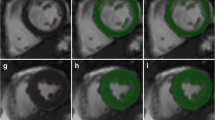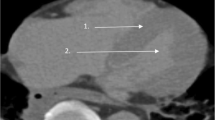Abstract
Background
Semiautomatic three-dimensional (3-D) threshold-based cardiac computed tomography (CT) quantification has not been attempted for left ventricular mass.
Objective
To evaluate the technical feasibility of semiautomatic 3-D threshold-based cardiac CT quantification of left ventricular mass in patients with various degrees of left ventricular hypertrophy.
Materials and methods
In 99 patients, cardiac CT was utilized to quantify ventricular volume and mass by using a semiautomatic 3-D threshold-based method. Left ventricular mass values were compared between the end-systole and the end-diastole. Volumetric parameters were compared among three left ventricular hypertrophy groups (definite, borderline, none). The reproducibility was assessed. The t-test, one-way analysis of variance and Pearson correlation were used.
Results
There were no technical failures. The left ventricular mass between the two sessions exhibited a small mean difference of 2.3±1.1% (mean±standard deviation). The indexed mass values were significantly higher at the end-systole than at the end-diastole (71.4±42.9 g/m2 vs. 65.9±43.3 g/m2, P<0.001), with significant correlation (R=0.99, P<0.001). The definite group (83.5±41.3 g/m2) showed statistically significantly higher indexed mass values than the borderline and none groups (64.7±26.9 and 55.6±23.9 g/m2, respectively; P<0.03), while demonstrating no statistically significant difference between the latter two groups (P>0.05). Left ventricular volume-mass and mass-volume ratios could be calculated in all three groups.
Conclusion
CT quantification of left ventricular mass using semiautomatic 3-D threshold-based segmentation is feasible with high reproducibility and the mass values and its ratios with ventricular volumes may be used in patients with various degrees of left ventricular hypertrophy.



Similar content being viewed by others
References
Stevens SM, Reinier K, Chugh SS (2013) Increased left ventricular mass as a predictor of sudden cardiac death: is it time to put it to the test? Circ Arrhythm Electrophysiol 6:212–217
Armstrong AC, Gjesdal O, Almeida A et al (2014) Left ventricular mass and hypertrophy by echocardiography and cardiac magnetic resonance: the multi-ethnic study of atherosclerosis. Echocardiography 31:12–20
Avegliano GP, Costabel JP, Asch FM et al (2016) Utility of real time 3D echocardiography for the assessment of left ventricular mass in patients with hypertrophic cardiomyopathy: comparison with cardiac magnetic resonance. Echocardiography 33:431–436
Chuang ML, Gona P, Hautvast GL et al (2012) Correlation of trabeculae and papillary muscles with clinical and cardiac characteristics and impact on CMR measures of LV anatomy and function. JACC Cardiovasc Imaging 5:1115–1123
Varga-Szemes A, Muscogiuri G, Schoepf UJ et al (2016) Clinical feasibility of a myocardial signal intensity threshold-based semi-automated cardiac magnetic resonance segmentation method. Eur Radiol 26:1503–1511
Sugeng L, Mor-Avi V, Weinert L et al (2010) Multimodality comparison of quantitative volumetric analysis of the right ventricle. JACC Cardiovasc Imaging 3:10–18
Kim HJ, Goo HW, Park SH, Yun TJ (2013) Left ventricle volume measured by cardiac CT in an infant with a small left ventricle: a new and accurate method in determining uni- or biventricular repair. Pediatr Radiol 43:243–246
Goo HW, Park S (2015) Semiautomatic three-dimensional CT ventricular volumetry in patients with congenital heart disease: agreement between two methods with different user interaction. Int J Card Imaging 31:223–232
Goo HW (2017) Serial changes in anatomy and ventricular function on dual-source cardiac computed tomography after the Norwood procedure for hypoplastic left heart syndrome. Pediatr Radiol 47:1776–1786
Goo HW (2018) Is it better to enter a volume CT dose index value before or after scan range adjustment for radiation dose optimization of pediatric cardiothoracic CT with tube current modulation? Korean J Radiol 19:692–703
Goo HW (2018) Comparison of chest pain protocols for electrocardiography-gated dual-source cardiothoracic CT in children and adults: the effect of tube current saturation on radiation dose reduction. Korean J Radiol 19:23–31
Goo HW, Allmendinger T (2017) Combined electrocardiography-- and respiratory-triggered CT of the lung to reduce respiratory misregistration artifacts between imaging slabs in free-breathing children: initial experience. Korean J Radiol 18:860–866
Goo HW (2018) Combined prospectively electrocardiography- and respiratory-triggered sequential cardiac computed tomography in free-breathing children: success rate and image quality. Pediatr Radiol 48:923–931
Goo HW (2011) Individualized volume CT dose index determined by cross-sectional area and mean density of the body to achieve uniform image noise of contrast-enhanced pediatric chest CT obtained at variable kV levels and with combined tube current modulation. Pediatr Radiol 41:839–847
Goo HW (2012) CT radiation dose optimization and estimation: an update for radiologists. Korean J Radiol 13:1–11
Goo HW (2018) Comparison between three-dimensional navigator-gated whole-heart MRI and two-dimensional cine MRI in quantifying ventricular volumes. Korean J Radiol 19:704–714
Buakhamsri A, Popovic ZB, Lin J et al (2009) Impact of left ventricular volume/mass ratio on diastolic function. Eur Heart J 30:1213–1221
Dweck MR, Joshi S, Murigu T et al (2012) Left ventricular remodeling and hypertrophy in patients with aortic stenosis: insights from cardiovascular magnetic resonance. J Cardiovasc Magn Reson 14:50
Krieger EV, Clair M, Opotowsky AR et al (2013) Correlation of exercise response in repaired coarctation of the aorta to left ventricular mass and geometry. Am J Cardiol 111:406–411
Luijkx T, Cramer MJ, Buckens CF et al (2015) Unravelling the grey zone: cardiac MRI volume to wall mass ratio to differentiate hypertrophic cardiomyopathy and the athlete's heart. Br J Sports Med 49:1404–1409
Han Y, Osborn EA, Maron MS et al (2009) Impact of papillary and trabecular muscles on quantitative analyses of cardiac function in hypertrophic cardiomyopathy. J Magn Reson Imaging 30:1197–1202
Park EA, Lee W, Kim HK, Chung JW (2015) Effect of papillary muscles and trabeculae on left ventricular measurement using cardiovascular magnetic resonance imaging in patients with hypertrophic cardiomyopathy. Korean J Radiol 16:4–12
Jacquier A, Thuny F, Jop B et al (2010) Measurement of trabeculated left ventricular mass using cardiac magnetic resonance imaging in the diagnosis of left ventricular non-compaction. Eur Heart J 31:1098–1104
Kozor R, Callaghan F, Tchan M et al (2015) A disproportionate contribution of papillary muscles and trabeculations to total left ventricular mass makes choice of cardiovascular magnetic resonance analysis technique critical in Fabry disease. J Cardiovasc Magn Reson 17:22
Schwarz F, Takx R, Schoepf UJ et al (2011) Reproducibility of left and right ventricular mass measurements with cardiac CT. J Cardiovasc Comput Tomogr 5:317–324
Mao SS, Li D, Rosenthal DG et al (2013) Dual-standard reference values of left ventricular volumetric parameters by multidetector CT angiography. J Cardiovasc Comput Tomogr 7:234–240
Klein R, Ametepe ES, Yam Y et al (2017) Cardiac CT assessment of left ventricular mass in mid-diastasis and its prognostic value. Eur Heart J Cardiovasc Imaging 18:95–102
Codella NC, Lee HY, Fieno DS et al (2012) Improved left ventricular mass quantification with partial voxel interpolation: in vivo and necropsy validation of a novel cardiac MRI segmentation algorithm. Circ Cardiovasc Imaging 5:137–146
Farber NJ, Reddy ST, Doyle M et al (2014) Ex vivo cardiovascular magnetic resonance measurements of right and left ventricular mass compared with direct mass measurement in excised hearts after transplantation: a first human SSFP comparison. J Cardiovasc Magn Reson 16:74
Budoff MJ, Ahmadi N, Sarraf G et al (2009) Determination of left ventricular mass on cardiac computed tomographic angiography. Acad Radiol 16:726–732
Supe-Markovina K, Nielsen JC, Musani M et al (2016) Assessment of left ventricular mass and hypertrophy by cardiovascular magnetic resonance imaging in pediatric hypertension. J Clin Hypertens (Greenwich) 18:976–981
Robbers-Visser D, Boersma E, Helbing WA (2009) Normal biventricular function, volumes, and mass in children aged 8 to 17 years. J Magn Reson Imaging 29:552–559
Sarikouch S, Peters B, Gutberlet M et al (2010) Sex-specific pediatric percentiles for ventricular size and mass as reference values for cardiac MRI: assessment by steady-state free-precession and phase-contrast MRI flow. Circ Cardiovasc Imaging 3:65–76
Kawel-Boehm N, Maceira A, Valsangiacomo-Buechel ER et al (2015) Normal values for cardiovascular magnetic resonance in adults and children. J Cardiovasc Magn Reson 17:29
Stojanovska J, Prasitdumrong H, Patel S et al (2014) Reference absolute and indexed values for left and right ventricular volume, function and mass from cardiac computed tomography. J Med Imaging Radiat Oncol 58:547–558
Takx RA, Moscariello A, Schoepf UJ et al (2012) Quantification of left and right ventricular function and myocardial mass: comparison of low-radiation dose 2nd generation dual-source CT and cardiac MRI. Eur J Radiol 81:e598–e604
Kara B, Nayman A, Guler I et al (2016) Quantitative assessment of left ventricular function and myocardial mass: a comparison of coronary CT angiography with cardiac MRI and echocardiography. Pol J Radiol 81:95–102
Author information
Authors and Affiliations
Corresponding author
Ethics declarations
Conflicts of interest
None
Rights and permissions
About this article
Cite this article
Goo, H.W. Technical feasibility of semiautomatic three-dimensional threshold-based cardiac computed tomography quantification of left ventricular mass. Pediatr Radiol 49, 318–326 (2019). https://doi.org/10.1007/s00247-018-4303-9
Received:
Revised:
Accepted:
Published:
Issue Date:
DOI: https://doi.org/10.1007/s00247-018-4303-9




